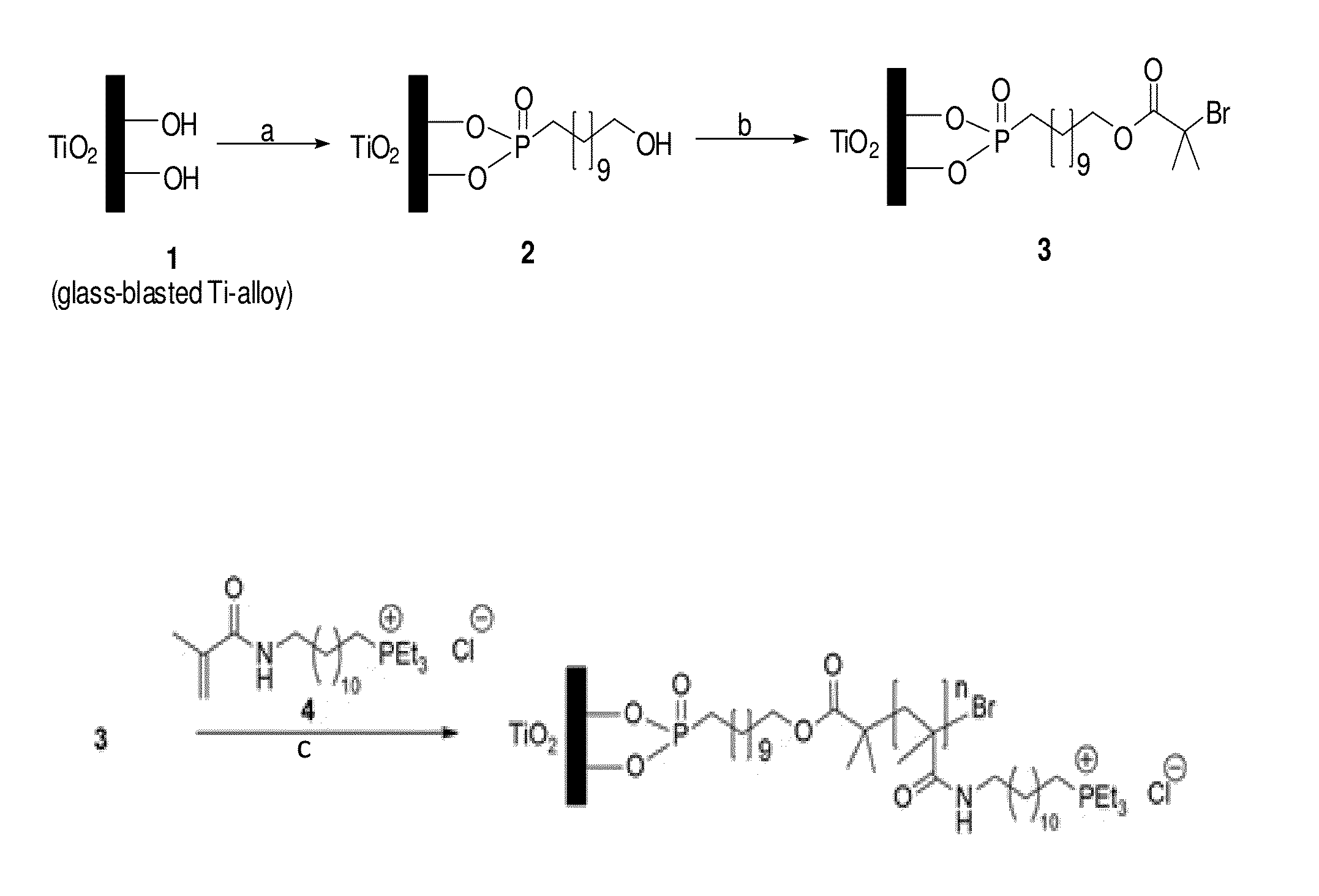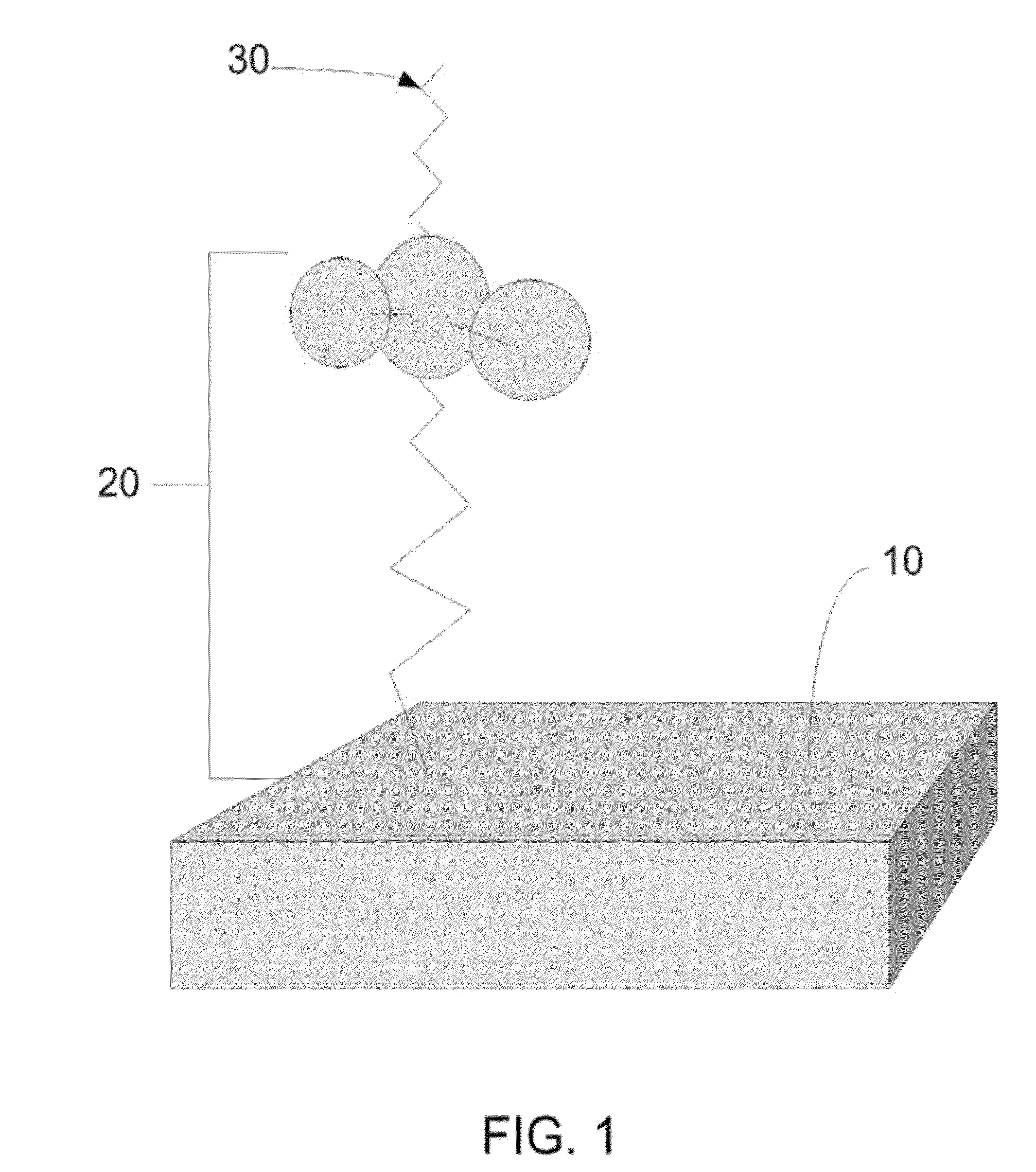Quaternary Phosphonium Coated Surfaces and Methods of Making the Same
a technology of quaternary phosphonium and surface attachment, which is applied in the field of surface attachment of quaternary phosphonium compounds with antibacterial activity, can solve the problems of compound harmful to mammalian tissue, need to be reapplied constantly, and ineffective administration, so as to reduce the incidence of deep infection, prevent pin-site infections, and minimize the potential for infection
- Summary
- Abstract
- Description
- Claims
- Application Information
AI Technical Summary
Benefits of technology
Problems solved by technology
Method used
Image
Examples
example 1
Synthesis of Antibacterial Polymer Brushes Via Surface-Initiated Atom Transfer Radical Polymerization (SI-ATRP)
[0136]Referring to FIG. 4, glass bead-blasted Ti-alloy (Ti6VaAl) coupons 1 were cleaned and contacted with phosphonoundecanol (PUL) in a 15 mM solution of PUL in ethanol, thereby covalently binding the PUL to the titanium alloy, and forming a Self Assembled Monolayer (SAM) of PUL on the titanium alloy surface as illustrated by numeral 2. Step a is also referred to, in some embodiments of the invention, as covalently binding a functionalizing agent to the surface, where the functionalizing agent in this instance is PUL.
[0137]The terminal hydroxyl group of the functionalizing agents 2 (PUL) were esterified with α-bromoisobutyryl bromide in dichloromethane to form the composition illustrated by numeral 3. Step b is also referred to, in some embodiments of the invention, as activating the surface, thereby preparing it for subsequent SI-ATRP of the linker (i.e. covalently bindin...
example 2
Synthesis of a Quaternary Phosphonium Compound Phosphonium Methacrylate
[0141]A 100 mL pressure tube was charged successively with acetonitrile (18 mL), triethylphosphine (2.05 mL, 17.3 mmol) and 12-bromo-1-dodecanol (4.00 g, 15.1 mmol). The mixture was heated at 90° C. for 2 days and concentrated in vacuum. The residue was dissolved in dichloromethane (10 mL). The solution was added drop-wise into ether (150 mL) with stirring to precipitate the product. After stirring for an additional one hour, the precipitates were collected by filtration, washed with ethanol, and air-dried to afford the target compound, i.e. Triethyl(12-hydroxydodecyl)phosphonium bromide (4.4 g, 65%).
[0142]To a solution of triethyl(12-hydroxydodecyl)phosphonium bromide (4.00 g, 10.4 mmol) in chloroform (50 mL) was slowly added methacryloyl chloride (1.07 mL, 11.0 mmol) at 0° C. and the mixture was stirred at room temperature for three days. Upon completion, the mixture was diluted with dichloromethane. Sodium car...
PUM
| Property | Measurement | Unit |
|---|---|---|
| Structure | aaaaa | aaaaa |
Abstract
Description
Claims
Application Information
 Login to View More
Login to View More - R&D
- Intellectual Property
- Life Sciences
- Materials
- Tech Scout
- Unparalleled Data Quality
- Higher Quality Content
- 60% Fewer Hallucinations
Browse by: Latest US Patents, China's latest patents, Technical Efficacy Thesaurus, Application Domain, Technology Topic, Popular Technical Reports.
© 2025 PatSnap. All rights reserved.Legal|Privacy policy|Modern Slavery Act Transparency Statement|Sitemap|About US| Contact US: help@patsnap.com



